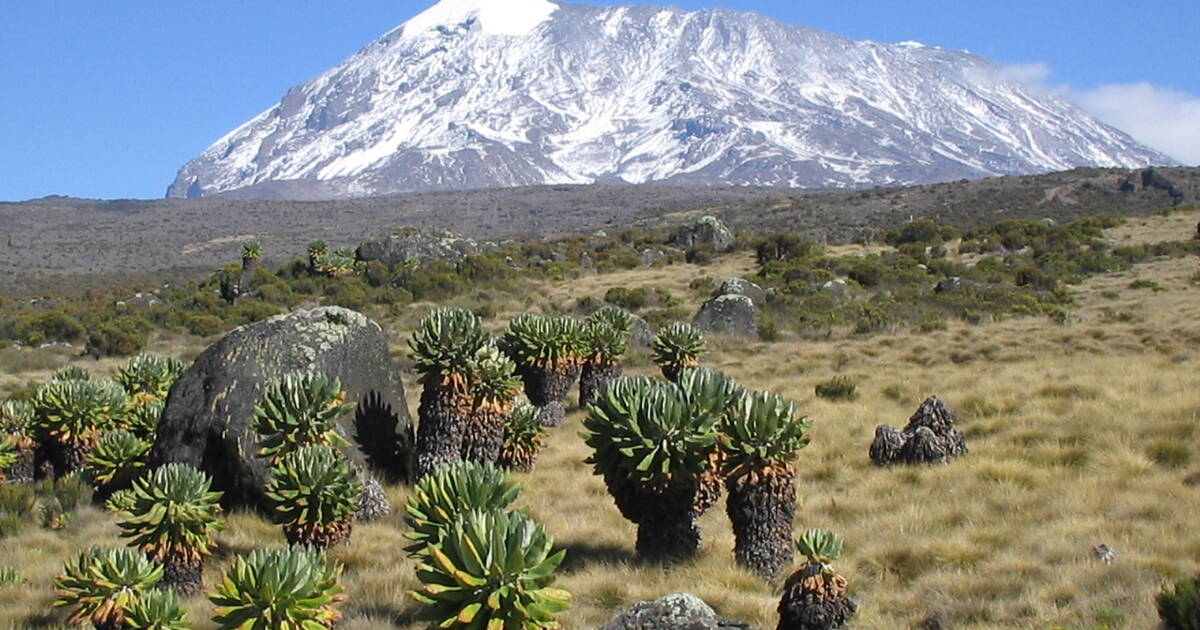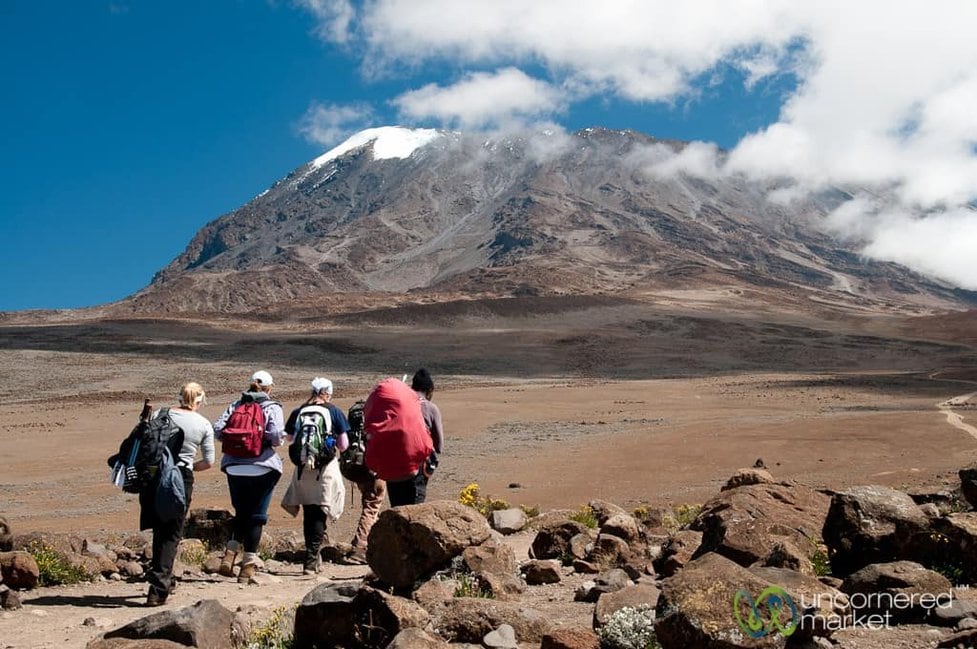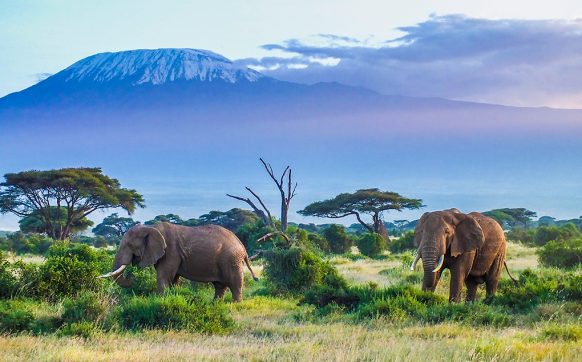Kilimanjaro National Park is a Tanzanian national park 300 kilometers south of the equator in Tanzania’s Kilimanjaro Region. The park is close to the Moshi town and border with Kenya. Mount Kilimanjaro, Kilimanjaro National Park is 1,688 square kilometers in size, with latitudes of 2°50’–3°10’S and longitudes of 37°10’–37°40’E. The park is managed by the Tanzania National Parks Authority (TANAPA), and its primary goal is to maintain and safeguard Africa’s highest mountain, Mount Kilimanjaro, as well as its habitats, ecology, and wildlife/biodiversity.

Kilimanjaro, at 5,895 meters, is Africa’s highest peak and the world’s tallest free-standing mountain, and it is protected and conserved by the Kilimanjaro National Park Authority, KINAPA. With its snowy top soaring above the savannah, this volcanic massif stands in stunning solitude above the surrounding plains. The park is home to a variety of mammals, many of which are endangered species.
Kibo, Mawenzi, and Shira are the three primary volcanic peaks of Mount Kilimanjaro. It is Africa’s highest mountain, with a snow-capped peak and glaciers. From the lowest to the highest point on the mountain, there are five main vegetation zones: lower slopes, montane forest, heath and moorland, alpine desert, and summit. Mount Kilimanjaro is regarded as an outstanding example of a superlative natural phenomenon because of its unique combination of characteristics, particularly its height, physical form, and snow crown, as well as its isolation from the surrounding plains.
HISTORY and FORMATION OF KILIMANJARO NATIONAL PARK.
Mount Kilimanjaro is made up of three volcanic cones that originated as a result of extensive continental rifting. Volcanic activity is considered to have started some 1 million years ago when molten lava began to burst through fractures in the lithosphere caused by the thinning of the crust. This lava had a low viscosity at first and expanded outward to form a gently sloping base. Continued eruptions released heavier, more viscous lava, eventually forming the Shira volcanic cone. The Shira cone fell into a vast caldera (a cauldron-like cavity much bigger than the original volcano) after volcanic activity halted, forming the Shira Ridge. Following eruptions, Kilimanjaro’s two additional main volcanic cones, Mawenzi and the currently inactive Kibo, as well as smaller parasitic cones, were formed.
Kilimanjaro was part of the German Protectorate in 1885, dating back to Tanzanian colonization. In October of 1889, Hans Meyer became the first European to ascend Mount Kilimanjaro, reaching the summit of Kibo. It was actually referred to as “Germany’s highest peak” at the time. Mount Kilimanjaro and its surrounding woods were designated as a game reserve by the German colonial administration until it was assigned to the British as a Protectorate under the League of Nations until Tanzanian independence in 1961. Kilimanjaro National Park was established in 1973, and it encompasses 1668 square kilometers of the mountain above 800 meters, as well as a forest reserve above the foothills. In 1987, it was designated as a United Nations World Heritage Site, and in 2005, it was expanded to cover the full tropical forest, where particular species found on a Mt. Kilimanjaro climbing fieldtrip are found nowhere else on the planet. The indigenous Chagga people still farm the lower slopes of the mountain.

WHEN IS THE BEST TIME TO VISIT KILIMANJARO NATIONAL PARK?
The best time to visit Kilimanjaro National Park is determined by the attractions and tourist activities you wish to participate in. Although temperatures do not vary significantly, there are seasons that are better for climbing Mount Kilimanjaro. The warmest months are January and February, making the hike more comfortable as you approach higher heights. It can be exceedingly cold at any time of year, with temperatures near or below freezing and cold winds.
The driest months are August and September, also making it a suitable time to climb Mount Kilimanjaro. The coolest months are June and July, which means the top might be significantly colder. It’s still a good time to go climbing. The rainy season months of April and May are the wettest. Therefore, avoid climbing Mount Kilimanjaro during those months. Although it is possible to climb in the rain during these months, it is more dangerous, difficult, and uncomfortable.
KILIMANJARO NATIONAL PARK ENTRANCE FEES
Kilimanjaro national park fees and costs vary depending on a variety of factors, including your country or geographic area, age group, activities, number of days spent in the national park, and style of lodging. Also the costing for Kilimanjaro national park specifically in hiking covers different aspects such as conservational fees, camping/hut fees, rescue fees, porter/guider/park ranger fee.
The entrance cost to Kilimanjaro National Park is USD 70 for non-east African people over the age of 16, and USD 20 for non-east African citizens between the ages of 5 and 15. The fee is paid per person every day spent in the park. Aside from the entrance charge, you must also add in rescue fees, camping fees, ranger fees, and the 18% government VAT.
ANIMALS AND BIRDS AT KILIMANJARO NATIONAL PARK
Because of the abundance of water and food, more animals survive in the lush tropical rainforests at the base of Kilimanjaro than in the highlands, this means that the higher you climb the mountain the few numbers of wild animals will be observed. the Elephants, Cape buffaloes, black rhinos, giraffes, leopards, servals, hyenas, baboons, monkeys, antelopes, aardvarks, mongooses, porcupines, honey badgers, ree hyraxes, and bush babies are just a few of the animals in the Kilimanjaro national park.
THINGS TO DO IN KILIMANJARO NATIONAL PARK/ TOURIST ACTIVITIES
Hiking to Uhuru Peak
This is one of the three largest peaks in Kilimanjaro National Park (kibo/Uhuru peak). Hiking to Uhuru peak takes approximately 5 to 8 days, depending on the ascending route you choose. Keep in mind that some routes are easy and others are difficult, that some roots take a long time to hike while others take only a few days, that some roots are expensive while others are not, and that most roots reward you with a good view of Mount Kilimanjaro and the animals. So, if you’re planning a climb to Uhuru Peak, make sure you pick a decent and acceptable route based on your interest in the sights you want to see as well as your energy level.
Bird watching
Mount Kilimanjaro national park is home to over 150 bird species, some of which are migratory and others endemic to this area, but you will also be able to see mountain birds and forest birds when ascending the mountain in different types of vegetation. White-necked Raven, resident black-shouldered kite, long-tailed kite, and a variety of other birds can be found in Kilimanjaro National Park. The best time to go birding is during the rainy season from November to April, when migrating birds from Europe and Asia arrive.
Wildlife viewing
More of these animals live in the lush tropical rainforests at the base of Kilimanjaro than in the highlands, so the higher you hike or ascend the mountain, the fewer animals you will see. Some of the wild animals in the Kilimanjaro national park include vervet monkeys, genet cats, honey badgers, aardvarks, baboons, Columbus monkeys, bush babies, elands, elephants, and others.

Cycling
Another popular type of adventure in the Kilimanjaro national park is cycling to Africa’s highest peak along the Kilema route; an additional fee may be charged for this activity. There are three primary stations to choose from. Cycling will take you through the Chagga people‘s farmlands. This exercise, however, should only be undertaken by experienced mountain bikers supervised by a knowledgeable tourist guide.
Nature guides walks.
Get a chance to interact more closely with the African wildness, particularly the wildness of Kilimanjaro National Park, where you will be able to see and interact with a variety of wild creatures, insects, and flora varieties. Tourists can go on guided nature walks through the Mount Kilimanjaro forest canopy, where they can see a variety of primates such as the red-tailed monkey, olive baboon, and white and black Columbus monkeys, as well as a variety of plant species, not to mention panoramic views of the Chagga farmlands and neighboring towns. In this fantastic tourist activity in Kilimanjaro National Park, you will be accompanied by a park ranger who will ensure your safety from dangerous animals.
Other visitor activities in the Kilimanjaro National Park include camping in various locations across the park, cultural excursions that include visits to the Chagga people who live in the area surrounding the park, picnicking, videography, and photography.
WHERE TO STAY IN KILIMANJARO NATIONAL PARK/ ACCOMMODATIONS
Kilimanjaro National Park offers a variety of accommodations to suit the needs of different guests, ranging from camping grounds where you can spend the night, to huts along the road as you approach the mountain, as well as some excellent lodges ranging from budget to mid-range to luxury lodges. However, because the park is close to the towns of Moshi and Arusha, you can elect to drive a short distance to those adjacent towns after viewing and completing your tour inside the park, where you will find a variety of lodging alternatives. The following are some of the most recommended accommodation options to spend the night when visiting Kilimanjaro national park.
ü Kaliwa lodge
ü Mai Kilimanjaro home stay
ü Teule guest house
ü Pink flamingo
ü Babylon lodge
ü Mount Kilimanjaro view lodge.
ü Kilemakyalo Mt. Lodge
ü Elerai camp
ü Aishi Machame hotel.
ü Kilimanjaro white house hotel


